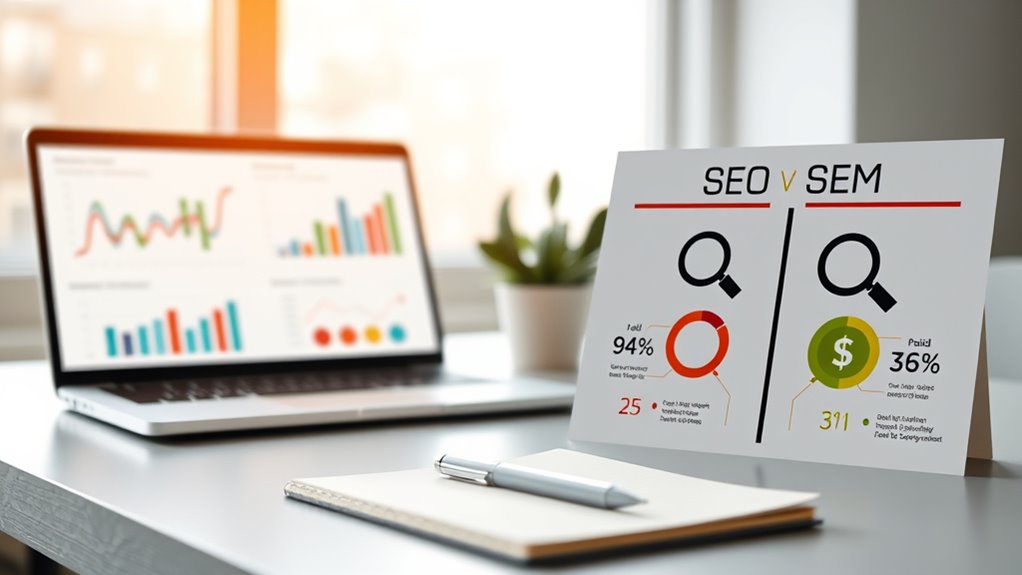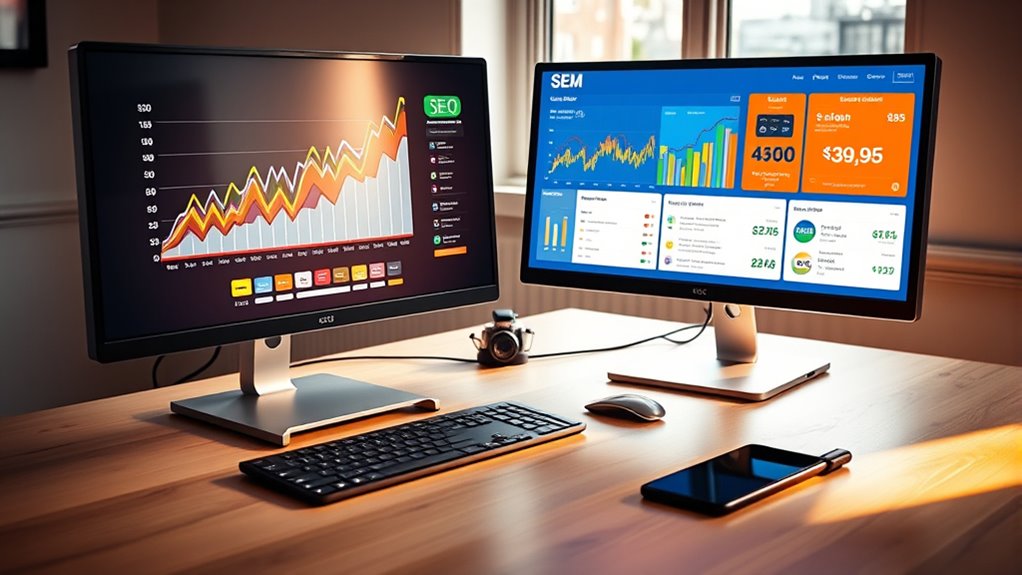SEO and SEM are both strategies to boost your website’s visibility, but they work differently. SEO focuses on optimizing your site for natural search rankings through content and technical improvements, offering long-term results. SEM involves paying for ads to appear at the top of search results, delivering quick, targeted traffic. Understanding these differences helps you choose the best approach, and if you keep exploring, you’ll find out how to combine both for maximum impact.
Key Takeaways
- SEO focuses on organic, long-term rankings, while SEM involves paid ads for immediate visibility.
- SEO builds authority through content and technical improvements; SEM uses targeted paid campaigns.
- SEO offers sustained traffic without ongoing costs; SEM provides quick results with continuous ad spend.
- SEO requires patience and time; SEM allows real-time campaign adjustments and budget control.
- Combining both strategies maximizes online visibility and achieves both short-term and long-term goals.

Understanding the differences between SEO and SEM is essential for crafting an effective digital marketing strategy. Both approaches aim to increase your website’s visibility and attract more visitors, but they do so in distinct ways. SEO, or search engine optimization, focuses on improving your website’s organic rankings through various techniques like keyword optimization, content creation, and technical improvements. When done well, SEO helps your site appear higher in search results without paying for each click. This long-term strategy builds authority and trust with search engines, which can lead to consistent, ongoing traffic. It requires patience because results take time to materialize, but once established, your site can enjoy sustained visibility without ongoing ad costs. Additionally, SEO often involves optimizing content for beneficial ingredients such as collagen and hyaluronic acid to enhance user engagement and results.
SEO builds long-term organic visibility through content and technical improvements, requiring patience but offering sustained traffic without ongoing costs.
On the other hand, SEM, or search engine marketing, involves paid advertising to get your site in front of potential customers quickly. When you use SEM, you create ads that appear at the top of search engine results pages, often marked as sponsored. You bid on keywords relevant to your business, and your ads are shown whenever someone searches for those terms. This approach provides immediate traffic and more control over when and where your ads appear. You can set specific budgets, target particular demographics, and adjust campaigns in real time to optimize performance. SEM is especially useful when launching new products, promoting limited-time offers, or competing in highly competitive markets where organic rankings are hard to achieve.
While SEO is a sustainable, cost-effective strategy that builds long-term value, SEM delivers quick results and greater control over your messaging. You might find that combining both strategies yields the best results, allowing you to benefit from the immediate impact of paid ads while building a solid organic presence over time. It’s important to understand that SEO involves optimizing your website and content to rank naturally, which can take months to see significant results. SEM, however, can generate traffic almost instantly once your campaigns go live, but it requires ongoing investment to maintain visibility.
Ultimately, your choice between SEO and SEM depends on your goals, budget, and timeline. If you want steady, long-term growth, investing in SEO makes sense. If you need quick visibility for a special promotion or to test new ideas, SEM provides the agility to reach your audience immediately. Most successful digital marketing strategies blend both approaches, leveraging the strengths of each to maximize your online presence effectively.
Frequently Asked Questions
How Does Keyword Research Differ Between SEO and SEM?
You focus on keyword research differently for SEO and SEM. For SEO, you target long-tail keywords with high relevance, low competition, and search volume, aiming for organic rankings. In SEM, you bid on specific keywords, including competitive ones, to gain immediate visibility. You analyze data to identify profitable keywords, adjusting bids and ad copy accordingly. While SEO emphasizes organic growth, SEM prioritizes paid placement to quickly attract targeted traffic.
What Are the Costs Associated With SEO and SEM Campaigns?
Think of costs in SEO and SEM as planting seeds versus buying plants. SEO costs include ongoing content creation, technical updates, and link building, which are more like a steady garden. SEM costs, on the other hand, are like paying for instant blooms through paid ads, with expenses for ad spend, bidding, and management. SEM often yields faster results but can drain your budget quickly, while SEO builds sustainable traffic over time.
How Long Does It Take to See Results From SEO and SEM?
You can typically see SEO results within 3 to 6 months, but it might take longer depending on competition and your efforts. SEM campaigns often generate quicker results, sometimes within days or weeks, since they involve paid ads. Keep in mind, consistent optimization and monitoring are key for both, so stay patient and proactive to maximize your success.
Can SEO and SEM Strategies Be Integrated Effectively?
Imagine your marketing efforts as two rivers converging into a powerful stream. You can effectively integrate SEO and SEM by aligning your keywords, content, and bidding strategies. When you synchronize these channels, it’s like steering a boat with both oars—boosting visibility and driving traffic faster. Regularly analyze performance metrics and adjust tactics, ensuring your combined approach flows smoothly, maximizing your reach and return on investment.
Which Method Offers Better Long-Term ROI: SEO or SEM?
You’ll generally see a better long-term ROI with SEO because it builds organic traffic and authority over time, leading to sustained visibility. SEM delivers quicker results through paid ads, but those benefits fade once you stop investing. If your goal is lasting growth, focusing on SEO is smarter, though combining both strategies can maximize immediate impact and long-term gains for your business.
Conclusion
So, the truth is, SEO and SEM aren’t really rivals—they’re just different tools for the same goal: boosting your online visibility. While SEO builds long-term organic traffic, SEM offers quick wins through paid ads. Both strategies work best when combined, giving you a balanced approach to reach your audience. Don’t buy into the myth that you only need one; instead, use both to maximize your results and stay ahead of the competition.









